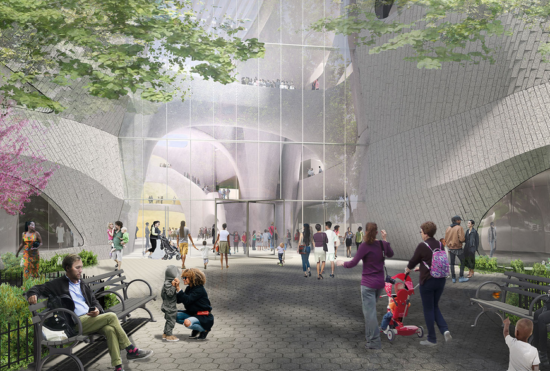
A rendering of the entrance to the Gilder Center from Columbus Avenue.
The city approved the Museum of Natural History’s plans to expand its campus, adding a new educational center and rerouting many of the interior passageways to make it easier for museum-goers to get around. But the ink had barely dried on the approval when an opposition group announced plans to sue over the project.
“Community United has been on a collision course with the Museum for more than two years as we sought to protect our neighborhood from a toxic and reckless plan that endangers the entire the Upper West Side community,” wrote Laura Messersmith, the co-president of Community United to Protect Theodore Roosevelt Park, in a statement to West Side Rag. “We are now at the zero hour and CU, represented by attorney Michael Hiller, will see the AMNH in court.”
The group argues that the project would create environmental hazards. The city environmental study, however, said that the site conditions “are similar in type and extent of contaminants to many urban areas, including throughout Manhattan. The proposed project would have no known risks with respect to hazardous materials that cannot be controlled through the use of measures commonly used at construction sites throughout New York City.”
The museum also responded to the group’s charge:
“Community United’s press release is unfounded and contrary to the comprehensive environmental review undertaken over the course of several years. As set forth in the Final Environmental Impact Statement, the project will not pose any public health risks with respect to hazardous materials. Materials of similar type and extent are commonly found at construction sites throughout New York City and can be controlled through the use of well-accepted remedial measures, which were reviewed and approved by the New York City Department of Environmental Protection.
To date, the Museum has not been served with a lawsuit. If and when a suit is filed, the Museum will respond at the appropriate time in the appropriate forum.”
The new center would encroach on the surrounding park, taking about one-quarter acre as seen in the before-and-after image below.
The city’s approval marks the culmination of a public review process that has lasted three years and involved “approximately 230 meetings and briefings with neighborhood residents, government officials, community organizations, and advocacy organizations,” according to the museum. It follows the 2016 approval by the New York City Landmarks Preservation Commission of the architectural and landscape designs for the project.
The Gilder Center, as it is known — a 245,000-square-foot, five-story, modern, stone-and-glass project, which will face Columbus Avenue and 79th Street and consume about a quarter of an acre of Theodore Roosevelt Park, the NYC park in which the museum is located — has been a flashpoint in the neighborhood since it was announced in 2015, spawning a series of anti-Gilder- Center groups and becoming a central issue in the recent City Council election.
Protestors decried everything from the loss of parkland and trees, to the design of the building, to the congestion it would create, to its negative contribution to climate change. The museum and its supporters extolled the educational value it would add, including increased access to collections and scientists at work, as well as the improved flow of visitors its 30 new connections between existing buildings would allow. Protestors called it a vanity project, designed for fund-raising galas. The museum described it as a place of wonder and discovery that would educate and inspire generations of young people, and help create a more “science-literate” citizenry, at a time when that is critically important.
The museum is in the process of obtaining building permit approvals; the application was originally filed months ago. If the suit goes forward, it could potentially interfere with the museum’s plans to open the museum to the public in 2020, at the conclusion of its 150th anniversary celebration.
Read about the changes coming to the park around the museum.



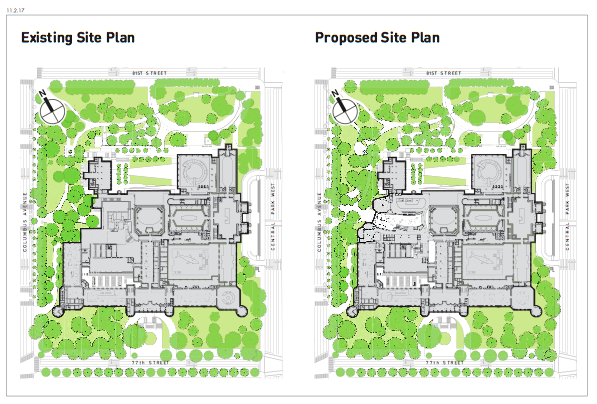

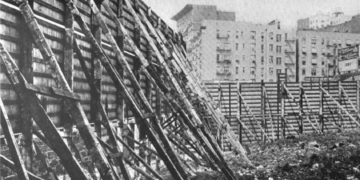

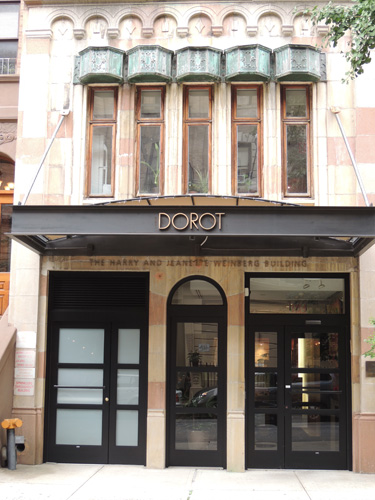
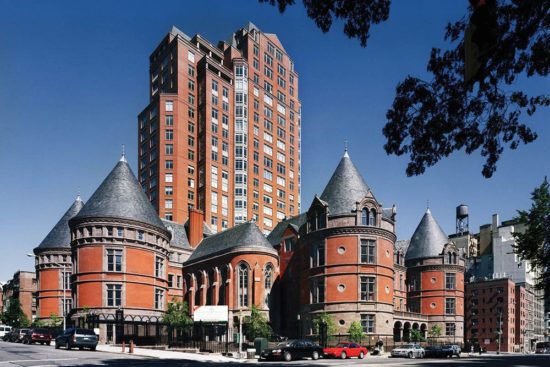
I fear this project has brought out the very worst of the UWS. And now they are going to sue?! Find something else to get involved in! There are plenty more worthy causes to be upset about than a museum expanding.
A lot of litigious people living in the UWS.
Like NYCHA flouting lead laws, yet another example of DeBlasio administration and allies needlessly risking residents health by giving lip service to processes and regulations designed to protect individuals and environment. So much for progressive agenda and credentials. More room in Iowa for Gilder Center.
Respectfully, I would rather have you move to Iowa than lose the museum expansion to that state.
No there’s plenty of room right here for the Gilder Center and my kids and I are happy we don’t have to go to Iowa to enjoy culture and science. The Upper West Side is fhe best and this will make it EVEN BETTER. But thanks anyway!
Ms. Messersmith seems given to extremism in her comments. I am an UWS resident, albeit at 71st & Columbis, bit I certainly don’t feel endangered from the proposed expansion plan. Not only does the addition give the museum needed space, the accompanying article shows how the museum will open additional park space to the public. I see it as a positive for the neighborhood.
I find the worry about “environmental hazards” here to be really absurd. There are building being built and renovated all over the UWS, why aren’t these activists protesting to stop those from being built
And 1/4 acre loss. My fellow UWSers must be really self-centered. Excuse me, but we have more access to parks than perhaps any other neighborhood in the NYC. There are loads of neighborhoods without decent greenspace and you have the nerve to complain about a little-used piece that will be used to expand a very used and beloved museum?
I go to the museum frequently and I am very familiar with the layout and it took me a bit to even figure out the differences between the two maps. The changes are quite minimal.
Trump is ramming through a horrible tax plan, limiting the civil rights of countless Americans, and embarrassing our nation globally. Homelessness in our neighborhood is becoming an increasingly visible problem. Schools are struggling for funding. And this is the problem these professional complainers are putting all of their efforts behind. I am embarrassed to be an Upper West Sider. This constant whining is why the Democrats lost – we look ridiculous.
Thank you. The lack of perspective and sense of these protesters is simply mind boggling.
Your summary is dead on.
yes, why spend hundred and thousands of NYcity $$ on a private institutions grandiose plan for a huge new entry hall, while the subways deteriorate and the homeless can’t get housed?
Yes-and one of the kingpins of Trump’s campaign and the owner of Breitbart News Rebekah Mercer is a trustee of the Museum of Natural History. She’s the head of an education advisory group. I wonder just what they’ll be teaching in that school when trustees of the museum have strong anti-climate change beliefs and bundles of inherited money. The building of this space age Barbarella building is not only an affront to the landmarked museum but it will be another entrance to the museum which will overwhelm this small park well beyond the 1/4 acre with many hundreds of tourists. So much for the neighborhood.
Thank God Trump won…he’s repealing unnecessary and frequently illegally implemented regulations, not backing down to violent lefty radicals and putting American citizens (and others here legally) first. How refreshing after the Obama years.
The AMNH needs new construction to stay modern and relevant. I welcome this new wing.
Community United is an embarrassment to all intelligent west side residents.
What I don’t care for are the endless robo calls from “Community United” to my phone during dinner trying to get me to object to the new plan. I’m in favor of the museum update just to stick it to Community United as they have been harassing me via phone for the last several months, all while I’m on the Federal Do Not Call list.
Dear Rick –
Community United is happy to be in contact with people interested in our mission, but we do not engage in robocalls or any other telemarketing.
All of our email communications have the option to unsubscribe for anyone who no longer wishes to receive our information. We take that very seriously.
I’m not sure who is calling you, but it is definitely not our organization.
I have two small children who go to the museum 3 times a week at a minimum. Why are we fighting this, the hart of the UWS is attractions like the museum which has been a staple for families since I was a child.
With all the problems in our county one would really hope the people involved in Community United should really put their energetic towards something more worthwhile. The changes to the park are truly minimal and their tactics are alarmist and overblown.
Beautiful old treess and welcome space for all ages–sue!
I support the museum on this one. I’d also love to see them using existing space better – the Restaurant That Never Was, next to the mezzanine fountains on the north side, could be very popular if it had decent food and was well promoted.
It’s disheartening and concerning that the initial release of information about this site given when the DEIS came out months ago did not have any of the underlying data about the toxicity of the site despite the data being readily available?
Instead, The Parks Department instead released the relevant data days before Thanksgiving with only a few days to respond to the FEIS with 8,000 pages of environmentally relevant information dumped in a disorganized and shuffled fashion.
Why would they do this, what are they hiding?
Well, most importantly, the AMNH uses and disposes of large quantities of ALL of the toxic chemicals found at the site.
Why is any of this relevant? Here are some of the site highlights from project documents:
Benzo(a)pyrene, benzo(b)fluoranthene, and dibenz(a,h)anthracene were detected above safe New York State Department of Environmental Conservation limits in 14 of 18 soil samples.
Tetrachloroethylene (PCE) and cis-1,2-dichloroethylene (cis-1,2-DCE) was detected above safe Aquifer Water Quality Standards.
Beryllium, chromium, lead, mercury, and nickel were detected in groundwater samples, with 21 unfiltered samples over safe Aquifer Water Quality Standards. 16 filtered samples were over safe Aquifer Water Quality Standards.
Trichloroethylene was detected in soil vapor above 4 µg/m3, exceeding New York State Department of Health limits.
Wow, that’s some scary stuff. Well, I’m sure they take this very seriously, and want to reassure the community who can easily google the horrible ramifications of being exposed to these toxic chemicals, let’s see how they described the gravity and seriousness of those findings at a site in a dense neighborhood: “similar in type and extent of contaminants to many urban areas, including throughout Manhattan.”
Wait, what? That’s right, in official documents about deadly compounds about to be disturbed in our neighborhood, the concerns of the community about the clear hazards of this project, and the extreme care needed to do any work there is brushed aside by referring to the existence of other toxic sites in Manhattan? Huh? 0 supporting evidence of that claim given, not that it was expected.
The afore mentioned statement is in no way relevant or germane to the issues that need to be addressed at this site, and a frightening attitude to boot. But certainly one those who have been meticulously working to see some measure of accountability about this projects impacts are at all unfamiliar with.
This neighborhood is deeply concerned that those in the de Blasio administration are not serious about protecting the health and well being of our citizens when it is costly or gets in the way of development ambitions.
Do we really think that the de Blasio administration is up to the task of safeguarding our health when only just last week, we read in the news about falsified reports of lead inspections that never took place, subsequently exposing kids to lead poisoning in NYCHA properties? What about when this administration then chose to lie repeatedly about what was going on to federal authorities and City Council rather than address the problem and stop the damage to the NYCHA residents affected?
I’m a little disappointed at the silly claims here that residents near the project site are somehow unreasonable for actually having done their due diligence for a project in their backyard.
I’m not sure why anyone who hasn’t been involved in this process would make a fool of themselves by making bold claims of this projects acceptability, safety, or implications for the neighborhood without knowing the basic facts first.
The AMNH should grow as needed, but not with wanton disregard for the surrounding community, afforded by political power several measures more than the residents who proudly call them neighbors.
It’s a funny juxtaposition, I remember reading abut when the Met last asked for more public parkland. Different city officials then, that would explain the City Council hearings, and the reasonable demand to come up with a master plan in order to make firm promises about their future ambitions, and how much more of our precious and finite greenspace they claimed they needed.
Quite a contrast to the AMNH flaunting their claimed rights to the entirety of TR park in the project documents. Don’t we deserve a city government that articulates not just the interim benefits, but the long term consequences of moving public assets into private hands vis-a-vis public/private partnerships? I think a more responsible city government isn’t such an unreasonable ask.
Are these chemicals unique to this site? Is it your view that their presence means that no construction should ever be permitted there? Is remediation impossible, or the measures they city referred to not adequate??
Not at all, but I’m very troubled at how my requests for specifics of the information only released recently with the FEIS were handled, which is to say completely ignored. Personally, I think we need to have a conversation about how they got there in the 1st place, what are the remediation plans beyond the site itself, and what we can do to have a better relationship of transparency and accountability with our neighbor. They state plainly in the FEIS (no idea why this was withheld from the DEIS) that they are subject to rules that require them to have the following:
Community right-to-know plan
Safety plan
Preparedness and prevention plan
Spill prevention plan
Countermeasure or control plan
I don’t think it is too unreasonable to ask for these to be included in a document referencing them. I doubt my focus would have lingered on this subject had their not been such an effort to withhold information until the last possible second.
Considering the following historic totals of chemicals disposed of by the AMNH, I think it is important to know and understand what if any connection there is to their processes, and have they corrected them.
318 KILOGRAMS of “Other PCB Wastes including contaminated soil, solids, sludges, clothing, etc.”
1710 Pounds of Benzene, 1,4−dichloro− Benzene found extensively and abundantly in the soil samples taken at the proposed Gilder Center Site.
400 Pounds of Tetrachloroethylene, methylene chloride, trichloroethylene, 1,1,1−trichloroethane, chlorobenzene, 1,1,2−trichloro−1,2,2−trifluoroethane, ortho−dichlorobenzene, trichlorofluoromethane, and 1,1,2−trichloroethane
There’s much more, but since they are historic totals, we have no idea whatsoever of how they relate to what we are talking about now. Not knowing is bad, especially because whether right or wrong, it makes us assume that we have to protect ourselves from the worst, since there is scant information to reassure us otherwise.
I don’t think I’m being unreasonable, trust but verify is old-school methodology that I think should be built into processes like these. I can;t do that when they withold the data, I can never get to the trust part that way. We really need to have a lot more faith in these environmental studies, they are used to justify massive changes in our city, especially zoning like East Harlem rezoning Inwood rezoning etc. Using them as a way to work backwards from a pre-ordained conclusion sure leaves a sour taste in people’s mouth about our local government’s ability to honestly and faithfully do their jobs.
It would really be beneficial for you to understand the sampling results and the regulations before you start the regurgitation of text from the report out of context (and incorrectly). So, start doing your own due diligence.
Clearly, you have no understanding of either, since your comment suggest you’d rather these SVOCs and VOCs stay in the ground forever not only at the AMNH, but all across the city. Plus, you don’t have any idea on how exposure to these pollutants could or would happen.
Only a fool would make making bold claims of this projects acceptability, safety, or implications for the neighborhood without knowing the basic facts first. Bill, please learn some of these basic facts.
This Trumpian response devoid of any actual rebuttal that smugly thinks it places the onus back on me is laughable. I’ve spoken to 2 former EPA attorneys and we commissioned our own world renowned enviromental engineeering firm to spell it out.
You’re trying to say that the onus is on me to provide evidence about how disturbing contaminants can expose us? Do your own homework, it’s very basic and the reason there is any concern in the first place, thus why they have to provide information about it.
Specifically, if you are referring to pathways exposure (write it down next time) then that is exactly why it is so troubling they did this big document dump at the end, and why they’ve completely ignored my plain request for basic information about their TSD protocols. Gee, you seem to have some really specific responses. If you published your name, it’d be easier to not dismiss you as a PR, lobbying, Parks etc shill. Until then, I’ll assume you are, especially given the deceitful framing of your question implying that restating clear evidence from the project’s own documents is somehow sordid or dishonest.
I’m going with PR…in house.
Please feel to share your specific expertise, and most importantly: actual specifics of how disturbing lead, chromium, benzene etc is by default safe, as your comment implies. There’s a whole neighborhood who would feel very reassured.
I have 20 years of working on environmental remediation, professionally, and you talked to an EPA lawyer once. Yes… you clearly know more. I’m being are sarcastic, if you couldn’t tell.
If you are going to state definitively that the neighborhood is at risk, you better be able to say how.
You realize that those metals you mentioned are bound to soil particles in soil, so unless you plan on breaking into the worksite and eating the soil there’s no ingestion exposure. Inhalation is also not possible, unless you standing on the soil while it’s being excavated. if you do, be sure and pack your poncho because they’ll be spraying down the soil so that the dust can’t travel. You’d know all this if you had actually read past the executive summary, but sure… you know more than me about this.
And by the way… I don’t work for the AMNH, the contractor that did the FEIS or any other interested party. As always.. ad hominem attacks say more about you than me.
what has a 10 story architectural showpiece entryhall to do with Education, Science and Innovation? NOTHING. “Education, Science and Innovation” is nothing but a smokescreen for this vanity, mostly taxpayer paid new entry, expected to handle up to million visitors per year and which will destroy a peaceful neighborhood oasis.
The “Education, Science and Innovation” objective itself could easily be acommodated within the exiting museum footprint.
if “Education, Science and Innovation” would be the main reason for the Gilder Center, it could be accommodated within the existing museum footprint. Many museums found ways to expand that way. The main objective however is a new showpiece entry hall, expected to draw hundreds of thousands visitors per year, and at a site singularly unsuited for that purpose. Also financed by lots of city’s taxpayers money. These are very legitimate objections.
OK,smart alex’s Wait until how horrible 3-4 years of
construction will be to build an “unnecessary building”
a quote from Architect Jeanne Gang, AND after the building
is built the enormous traffic, buses, people, etc will
happen. AND, maybe this might even impact real estate
values in the area due to the congestion and unpleasant
traffic, etc.
Wait. You’ll find out the hard way.
And no thanks to the Landmark Preservation people. They
are useless.
Your use of the work “consume” in your article is perfect and I will appropriate it because that is what the new Museum will be doing.
The Gilder Center, a massive building will consume energy galore. In this day and age of climate change, there is not a sign or an attempt to acknowledge this–not a solar panel in sight. In other words, they will be burning fossil fuels which is, as is well-known, a pollutant. The UWS, where huge luxury condos are consuming energy, not only in their everyday functions of any building, but in the traffic that ensues due to the increase in the goods and services necessary. The traffic, I find is usually from early morning to early evening, primarily coinciding with the arrival of school and tourist buses into the area during the week and often on Sat. and Sunday depending on the season.
In addition, the prime mover of this unfortunate effort, Richard Gilder, believes that man has conquered nature! In the case of the Rose Center, Gilder was in charge of hiring and I assume he will do likewise should a Science and Educational building go up (heaven forfend!) In addition, it was not until Sept. of 1996, that the American Museum had to be coerced by a consortium of Natural History Museums around the country, as well as environmental groups, into divesting the Museums fossil fuel investments. The Museum has accepted monies as well from Monsanto, the great poisoner of the soil.
Do you really want such person heading a Science and Education Museum, particularly to our children?
So, in addition to this huge and consuming, energy-guzzling building, plus the increased traffic which creates carbon dioxide, they wish to cut down a magnificent tree canopy made up of seven 125+ year old trees. Something I learned in elementary school is that trees consume carbon dioxide, and in return emits oxygen which is essential to human life. How can anyone trust a person as Mr. Gilder to be in charge of a Science school?
I’m going to reiterate what some other posters have implied. There are so many bad things happening in the world today. So many things that are increasing our personal, communal and social sense of vulnerability. The museum expansion is hardly something of comparable concern. That people are spending their energies opposing THIS rather than UWS hunger, poverty, homelessness, unemployment, pollution, safety & security… it’s just so disheartening.
Yes and then why Michael would the city and the state not take the millions of dollars they are spending to foot a substantial part of the bill for this “school” (with a board of trustees full of climate deniers) and spend it on housing for the homeless, college scholarships, food programs for poor children, Meals On Wheels, WIC, a transit system deemed in a state emergency. Why? Because of the apathy and complacency as exhibited in the comments seen here. Our country is in crisis, and we are delighted to build vanity projects with lots of tax dollars and taking away public assets in the form of a park and privatizing them. On a piece of property in NYC the size of a walled city. Priorities are so out of whack. Progressive city? I don’t think so.
Having gone to virtually every public meeting to do with the proposed Gilder Center and having attentively taken in the positions of both the museum and neighborhood opponents, what rises above all in my mind, though apparently wholly lost in the fray, is this: Jeanne Gang, the project architect, has stated on more than one occasion that the museum’s need for continuous flow for their exhibition installations as well as all the spaces required for their expanded educational aims could be achieved within the museum’s current footprint . . . without encroaching in the slightest into Teddy Roosevelt Park.
Just as significantly, if not even more so, Ms. Gang has also stated that if the administrative staff could relocate its offices off-site, the entirety of the museum’s needs could be met by simply reconfiguring the extant structures alone. Implicitly, that would mean: No demolitions, no exterior excavations, no disruption of toxic materials and substances above ground and below. No loss of trees, bucolic grassy expanses, precious perches for tranquil repose, etc.,etc., etc. In brief, the museum could get all of its needs met AND the public parkland could be preserved completely untouched.
About this atrium, however, I do land on the side that views this architectural element with its touted fourth grand entrance as utterly unnecessary, even indefensible. And, as for the museum’s pressing the case that the atrium is vital “as a place of wonder and discovery that would educate and inspire generations of young people,” to quote the article . . . with all due respect, that is flat-out fatuous. Seriously. Think of it. The museum itself is an endlessly opening, wondrous world of awe-inspiring artifacts and sights that ignite curiosity and appetite with every step, at virtually any point, and for all people of absolutely every age.
So, after three years of this sweep of public presentations and debates, it looks that if this atrium were eliminated, this long-standing contentious clash could be easily converted into a congenial accord, a real win/win for both the museum, a private institution with aspirations to expand, and the Theodore Roosevelt public parkland with its self- preservation imperatives, by way of either of Ms. Gang’s two alternative building plans as noted above .
As a resident of the UWS for 20 years, and supporter of many environmental causes, I’ll happily add Community United to my list of causes to never support. This is absolute nonsense and a waste of city money to fight this frivolous lawsuit. Thanks for wasting my taxes to fight your idiocy.
If this project goes through, millions of taxpayer dollars will be used to fund a showy gala space in a time of homelessness and hunger. The Parks Department and our politicians should be ashamed.
On Monday, the de Blasio administration approved the annexation of Teddy Roosevelt Park on the UWS.
On Tuesday, the Trump administration sharply reduced the Bears Ears national park in Utah.
These acts are united by their disdain for nature, their cavalier attitude towards the climate crisis and their failure to include the citizenry in the decision-making process.
The museum’s expansion will add two million tons of pollution to our air annually. The Trump rollback of federal land will likely open preserved public acres to fracking.
Both assaults on Mother Earth are fueled by private interests and funded-justified by climate deniers.
Shame on our elected officials – City Councilwoman, Borough President, Comptroller and Mayor for their complicity in the museum’s land grab. Shame on the President for his environmental perfidy.
Finally, shame on Community Board 7 which announced on Wednesday, that they won’t hold a community meeting on the museum’s toxic proposal.
From reading the responses here I’m left to wonder if any of you people actually use that park space or visit? Have even been to any of the meetings over the years? Educated yourselves in any way aside from this obviously slanted article? Do you live near this massive 3-4 year project that will affect your daily life or finances should you try and sell your condo once construction starts? Yeah…..I thought not
Everyone should be ashamed of a city that builds private projects on public parkland! And if you want to relate this back to trump, take a look at the AMNH’s ‘educational board’ and ask yourself why a trump donating, flat earthier like Rebecca Mercer is heading it…then ask yourself again if you believe the Mercer’s really want to bring a top notch educational center in the Gilder Center. When did NYers become so guilable?
Anyone want to buy a gold watch?
When the Gilder Center gets built, it should include a diorama dedicated to Communitus Unitedus, an extinct species of reckless protesters that were once a menace to the well-being of the Upper West Side.
such a boring museum. you have tons of space… use it.
Fully agree with IZ – look at the two site plans above – they are virtually identical – maybe 5 trees are lost. If you want to pick a battle against something that is going to ‘destroy the UWS’, go sue EXTELL and their plan to build a 775 ft tall building mid-block on 66th St. That will create an “environmental hazard”, and certainly a congestion nightmare on 66th St (and CPW, and the Transverse…)!
Any evaluation about the Park should be made in person, on the ground and not on a drawing board. When it is 90 degrees at 9 AM, this is the deepest, coolest shade. It is also the most quiet spot. As a park should be.
“Paving over park land is never a good idea” and “The community should be very involved in the decision-making process”–this was the conclusion by Community Board 7 last month regarding changes to Central Park where Tavern on the Green had a parking lot. Why has the process for Theodore Roosevelt Park been the opposite? Both the architect and the museum’s consultants said they could achieve what they need without expanding into the park. Please follow up. Thank you.
Are they serious?! When I’d read about the protesters before, I thought the museum was going to take up the entire park, not that tiny addition!
It’s things like this that make protests of all kinds look silly and make people not pay attention.
The Museum has compromised enough. Community United has had its impact, but it’s time to let the Gilder Center happen. I supported CU originally, but I am bothered to see how many different excuses are being made for their NIMBY agenda. Is it the loss of trees? The traffic? Environmental hazards? Change to the neighborhood atmosphere? It seems that each time a compromise is offered by the Museum, CU comes up with another reason to oppose the expansion. Enough! The new footprint is a tiny change, and the opening of the Margaret Mead Garden and the improvements to the dog run will serve the neighborhood well.